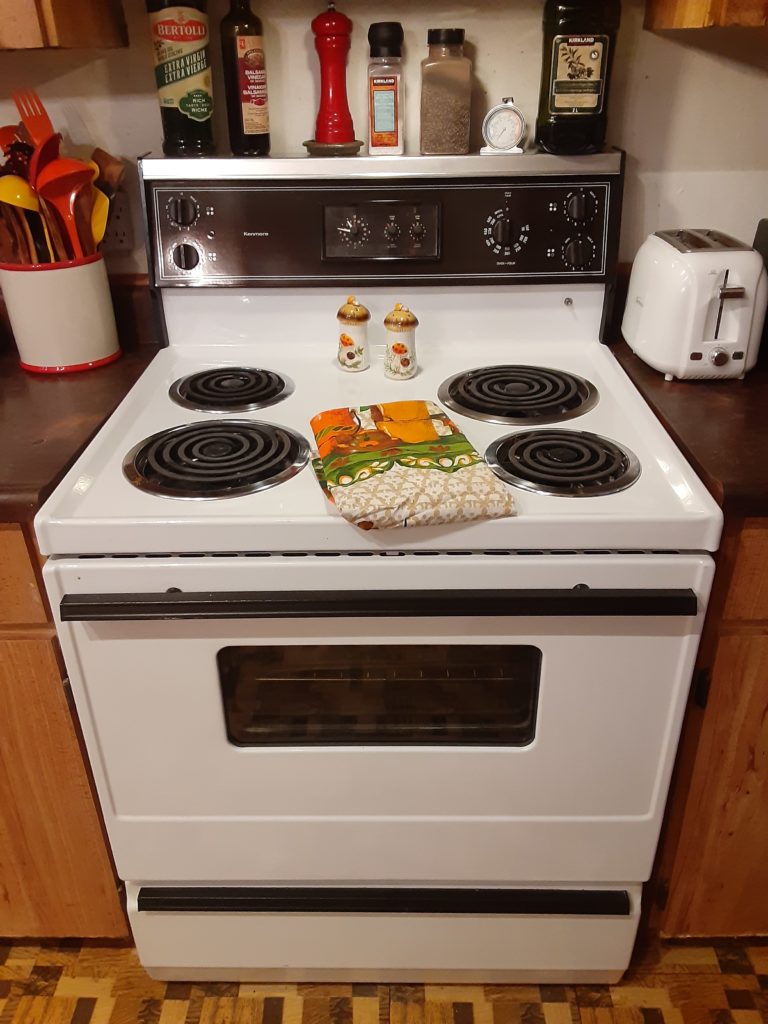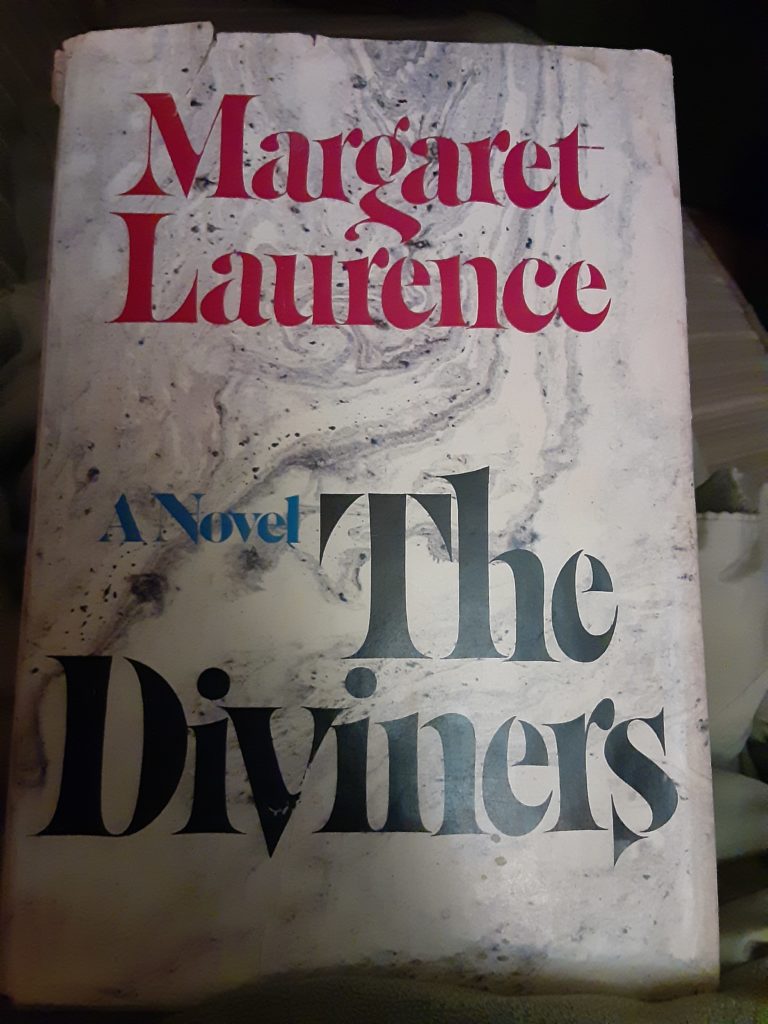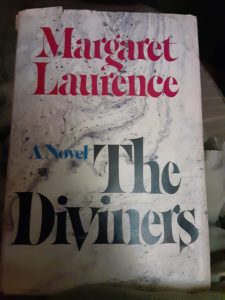Wherein I Enter my Luddite Years
 Late last week we took delivery of our new stove—a circa 1988 coil-topped Kenmore electric range with analogue dials and a large capacity oven. Behold it in all its glory—brown-black back panel, wide coil burners, styled with a set of Merry Mushroom salt and pepper shakers, and an of-the-era apron to match.
Late last week we took delivery of our new stove—a circa 1988 coil-topped Kenmore electric range with analogue dials and a large capacity oven. Behold it in all its glory—brown-black back panel, wide coil burners, styled with a set of Merry Mushroom salt and pepper shakers, and an of-the-era apron to match.
The story of this stove is a bit involved, so you might want to stretch out on a Dacron upholstered colonial patterned chesterfield with an acrylic crocheted afghan (in, say, brown and orange stripes) to read it.
Over the decades I have cooked on quite a few different stoves, including, for ten long years, an electric hot plate. My favourite stove, the one still standing in the secondary kitchen of our formerly apartmentized and then multigenerational family home, is a gas range that generates a lovely and responsive heat. But there is no gas line to the ground floor kitchen, and after 40 years of hard use, the rusted old electric stove with wonky burners and a malfunctioning oven element was overdue for replacement.
In 2020 my mother-in-law’s dementia had progressed to the point where she could no longer live on her own, so we sold her condo and moved her into our home. We had hoped that inhabiting the ground floor unit would help her retain some sense of autonomy—but shortly thereafter realized we needed to disable the stove for safety reasons. In August, after moving my mother-in-law into long term care, we plugged in the stove for the first time in three years and realized it was too far gone to fix.
That was when our difficulties began.
At Home Depot we learned that coil-top electric stoves are a species in decline. The coil-tops they do continue to carry include safety devices that limit cooking duration and temperature—a problem for a cook like me during preserving season, when water-bathed bottles of jams and jellies require a steady rolling boil be maintained under them for long enough to ensure a shelf-safe seal. Most of the ceramic-topped stoves now available are not designed for the weight, kettle diameter, or heat requirements of preserving. And buying an induction stove would mean replacing most of my cookware.
I considered buying an electric canner or portable hotplate so I could continue to make preserves—but it seemed ridiculous to buy a new stove and then still need to buy another device to use for canning.
Fellow preservers, including kind fellow members of the Culinary Historians of Canada, offered helpful advice—some people continue to make preserves just fine on their coil burner or ceramic-topped stoves; others have gone with high wattage portable cooktops—but it seemed that most of the people happily preserving using their ordinary stoves are using older models.
Of course they are.
In our household we take care to reduce our environmental impact. We are longtime thrift hounds, always brake for yard sales, and have picked up so many useful things at curbside over the years that we once published an essay about them. We walk, bike or rollerblade whenever it is possible to do so, and gas up our 14 year-old car about once a month. We limit our energy use, compost, make do and mend, and generally try to live as lightly on the earth as is practicable in contemporary urban Canada.
When it comes to appliances, however, we’ve found our options increasingly limited. Not so many years ago there was an appliance repair place in every neighbourhood. Here in the Junction even a decade ago there used to be four or five storefronts selling second-hand appliances lined up along Dundas Street West.
It’s not just rising commercial rents that have priced these businesses out. It’s that contemporary appliances are simultaneously vastly more complex and much more fragile. Most appliances—even fridges—now have motherboards. When something goes wrong, it is often cheaper to just replace the whole appliance. In many cases the internal workings are simply not serviceable, no matter how skilled the repair person, meaning that many broken appliances are suitable only for the scrapyard. A salesperson at a midtown appliance showroom told us frankly that the ‘sunset’ on new midrange fixtures is about eight years.
Yikes.
By good fortune and Google, we found a small used appliance shop called Appliance Specialist located about 10 blocks from our house. We went in and sitting in the shop was the perfect stove—electric, coil-topped, large, white, made in Canada and, as a bonus, fully analogue in its operation. The owner, a gentleman originally from Guyana, knows a great deal about appliances, digital and analogue, new and old. He is also, it turns out, an ordained minister, a songwriter, and a gifted landscape photographer. Within the hour our new stove was nestled into our kitchen, where it has been put to daily use ever since.
In my local parent network someone posted a few days ago seeking advice about sourcing a new washer-drier set. In response, commenters extolled the virtues of analogue-only machines, and detailed the troubles they’ve had with the digital components even on expensive machines. Most of these commenters are thirty-somethings with young children, meaning they are what sociologists call ‘digital natives‘ who have likely transacted their entire lives in a post-analogue world.
It occurs to me that there must be a huge potential market for well-built, lasting analogue equipment. At a time when the environmental consequences of human consumption are deeply evident, when the mined materials that go into computer components are increasingly short supply, and when international conflicts have disrupted global supply chains, it seems more than a bit risky to rely on an appliance that will likely require replacing in a few years, and whose cheapness may come at the cost of labour and environmental protections. Economists and policy makers have begun talking about ‘nearshoring’ and ‘reshoring’ manufacturing to reduce some of these risks—what a boon it could be if well-built, truly durable goods came back into vogue.
And don’t even get me started on furniture.
Wherein I Enter my Luddite Years Read More »









